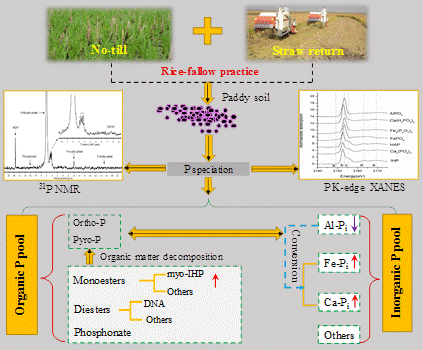| Synchrotron radiation technology revealed the real status of phosphorus species in conservational tillage soils at molecular scale |
| From: PublishDate:2020-07-31 Hits: |
The status of the phosphorus pool controls its bioavailability of in the agricultural soils, which is crucial to the turnover of nutrients among soil, plant, and environment. The traditional continuous extraction method of phosphorus fractions has only operational significance and cannot reflect the real phosphorus forms in the soil. The development of X-ray absorption near-edge structure spectroscopy based on synchrotron radiation has provided more accurate phosphorus species information at molecular scale. Although some studies have used this technique to conduct preliminary studies on the characteristics of phosphorus in some soils, the key evidence of phosphorus species and transformation characteristics of conservational tillage soil is still unclear. In December 2019, a research team led by Professor Liang Xinqiang from the college of Environmental & Resource sciences of Zhejiang University published a paper entitled "The influence of no-till coupled with straw return on soil phosphorus speciation in a two-year rice-fallow practice” in the journal of Soil & Tillage Research. Through a two-year field experiment, they revealed the pecies of phosphorus and its transformation process in the conservational tillage soils using P-k-edge synchrotron radiation technology.
Effect of conservational tillage on soil phosphorus spiecies at the molecular scale The study found that conservational tillage (no-till + straw return) significantly increased soil total phosphorus and available phosphorus content. P K-edge XANES spectroscopy analysis further revealed the impact of conservational tillage on the different characteristics of the relative proportions of phosphorus bound to calcium (Ca), iron (Fe) and aluminum (Al) oxides in loam and clay soils. At the molecular scale, two years of conservational tillage increased soil Ca and Fe oxide-bound phosphorus by 10.4%-27.6%, respectively; while the relative proportion of Al oxide-bound phosphorus decreased by 38.6%-40.7%. This confirmed conservational tillage can improve the bio-availability of soil phosphorus. This study provides a theoretical basis for us to understand the turnover mechanism of phosphorus in conservational tillage soils. In this work, the Beijing Synchrotron Radiation Facility (BSRF) provided key technical support, and the true species of phosphorus in the soil was revealed by the P K-edge XANES spectral analysis technique. Professor Liang Xinqiang of the college of Environmental & Resource of Zhejiang University believes that "This work is an important supplement to the phosphorus management strategy in conservational tillage soils. The bio-availability of soil phosphorus is closely related to its occurrence forms. However, the current continuous extraction method cannot reflect the true species of phosphorus in the soil. Synchrotron radiation P-k-XANES spectral analysis technology can be complementally used with 31P-NMR nuclear magnetic resonance technology to explain the soil inorganic and organic phosphorus species at molecular scale. These studies will certainly help to uncover the mysterious veil of soil phosphorus pool and provide the possibility of improving the bioavailability of phosphorus and reducing its losses from agricultural soils” Article: Fayong Li, Xinqiang Liang*, Huifang Zhang, Guangming Tian. The influence of no-till coupled with straw return on soil phosphorus speciation in a two-year rice-fallow practice. Soil & Tillage Research 195(2019), 104389. |
|
|
| Chinese
- Metal-free efficient photocatalyst for stable visible water splitting——Top ten major scientific progresses in China in 2015
- The nano-resolution imaging platform was awarded the first rate prize of Beijing Science and Technology in 2014
- Beamline 1W1 of BSRF started to runoperate in the couplingparasitic mode of BEPCII
- Synthesis of High Performance Polymer Materials for Field Effect-Transistors
- Surfactant molecular aggregates in green solvents
- GIXRD has played an important role in the characterization of organic thin-film transistors
Science Highlights
Home /
Copyright © 2011 - 2012 Beijing Synchrotron Radiation Facility


